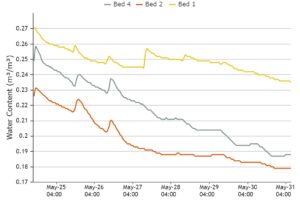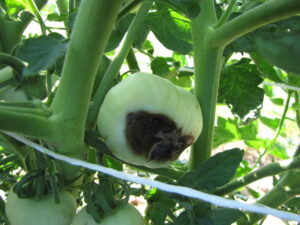Tomatoes need a consistent water supply when they start to bloom and set fruit. As plants grow more foliage and have more fruits set, their water needs increase. As a result, the irrigation amount must steadily increase to maintain the consistent soil water content and the water supply to the plants.
What would happen if we failed to provide plants with a consistent water supply? The most noticeable effect on tomatoes might be blossom-end rot (Figure 1). Some may argue that blossom-end rot is caused by a calcium deficiency. This is true. But usually, in soil-based production systems in our region, there is plenty of calcium present. It is a water supply issue that prevents calcium from translocating to the fruit tip and causes blossom end rot. This is a different situation compared to soilless substrate production, where applying fertilizers containing calcium is usually needed.
Generally speaking, if the soil water content is maintained consistently from fruit set throughout the season, blossom-end rot can be largely avoided. However, this is easier said than done and may need soil water content monitoring with moisture sensors.
Below is an example of the research high tunnel with tomatoes grown in sandy soil. The tomatoes were transplanted in the tunnel on April 13, 2023. We started regular irrigation around early May. We irrigated the high tunnel daily with about 55 gallons of water in the past two weeks. We did not realize we were short watering until we saw that the soil water contents measured by moisture sensors decreased dramatically in the past seven days by around 30% (Figure 2), which raised the alarm that we needed to increase irrigation immediately.

Figure 2. The decrease of soil water content at 12’’ depth in three beds in a tomato high tunnel in the past seven days at Southwest Purdue Ag Center. The plants were irrigated daily. Note: we can see the water content response to the irrigation event in the first three days but not after May 28.
The next question would be at what level of water depletion tomato blossom-end rot would appear. We do not have a definite answer to this question. The different types of tomatoes and cultivars vary greatly in their tendency to develop blossom end rot under water stress. For example, blossom end rot may not be an issue for cherry tomatoes, even when the plants severely suffer from water stress. In contrast, slight water stress may cause some blossom end rot on certain slicer tomato cultivars. This article described a case study showing how a susceptible cultivar developed blossom-end rot tomatoes under different levels of water stress.
Funding for the project Improve Drip Irrigation Management for Vegetables and Melon Production in Indiana was made possible by the Indiana State Department of Agriculture through grant A337-22-SCBG-21-003. Its contents are solely the responsibility of the authors and do not necessarily represent the official views of the ISDA.
